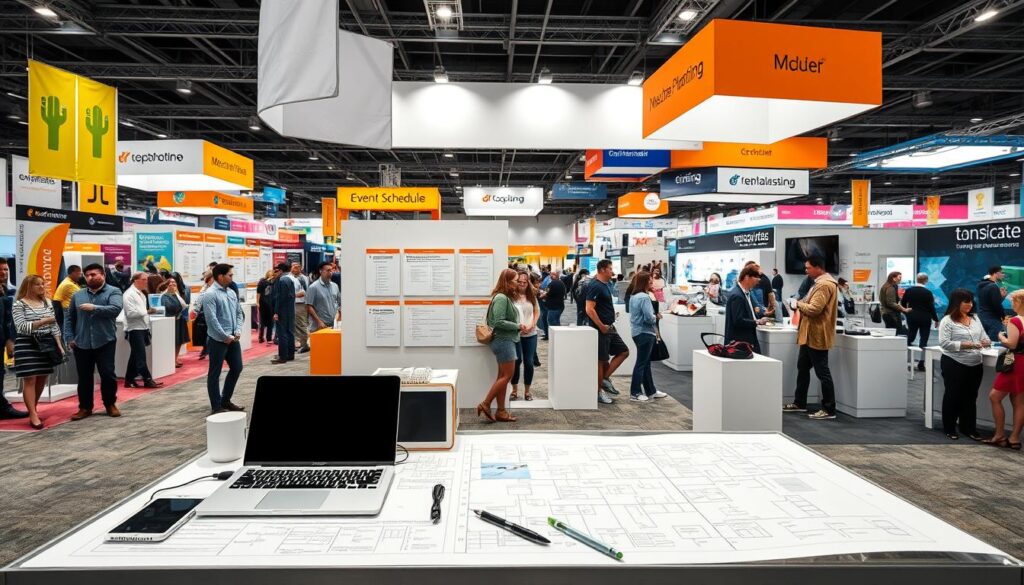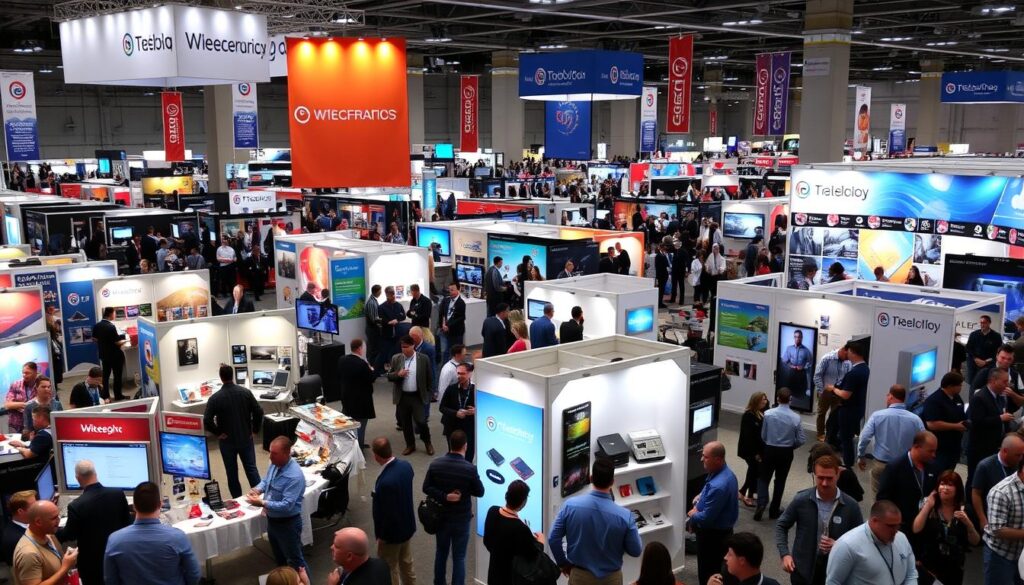תכנון תערוכות מסחר חיוני עבור אירוע מוצלח. ידוע בתעשיות שהאירועים האלה מעלים את נראות המותג שלך. הם גם עוזרים ב- רשתות ומאפשרים מחקר שוק.
מדריך זה יכסה את השיטות המובילות לקיום תערוכות מסחר. המטרה היא לשפר את אסטרטגיית התצוגה שלך. עקוב אחרי הטיפים הללו כדי להפוך את התערוכה הבאה שלך ליעילה ולא נשכחת.
מסקנות מרכזיות
- תערוכות מסחר משפרות באופן משמעותי את נראות המותג.
- הקמת מטרות ברורות לפני תכנון התערוכה שלך.
- תקציב אפקטיבי הוא קריטי להצלחת התערוכה.
- בחירת מקומות התערוכה שנגישים עם ציוד הנדרש.
- עיצוב סטנד מעניין מושך יותר מבקרים.
- ניצול טכנולוגיה כדי לשפר את האינטראקציה עם המשתתפים בתערוכה שלך.
הבנת חשיבותן של תערוכות מסחר
תערוכות מסחר הן הזדמנות גדולה לעסקים לצמוח בשוק. הן מאפשרות לחברות להציג את מוצריהן ושירותיהן למספר רב של אנשים. זה עוזר להפוך את המותג לנראה יותר. באירועים אלה, עסקים יכולים לפגוש לקוחות אפשריים ואנשים חשובים בתעשייה. זו הזדמנות לשיחות משמעותיות.
השפעה על נראות המותג
השתתפות בתערוכות מסחר יכולה באמת להפוך את המותג ליותר נראה. חברות יכולות להציג את מה שהן מציעות במקומות חדשים. כאשר אנשים רואים את המוצרים והשירותים שלך, הם מתחילים לבטוח ונשארים נאמנים למותג שלך. תערוכות מסחר הן תוספת נפלאה לסיכוי של החברות להשאיר הרבה רושם טוב.
הזדמנויות רשתות
תערוכות מסחר הן נהדרות לפגישת אנשים אחרים בתחום שלך. האירועים הללו מושלמים למציאת שותפים ולהתחלת שיתופי פעולה. חברות פוגשות מגוון אנשים, שעלול להוביל ללקוחות חדשים ומכירות. הקשרים האישיים שנוצרים כאן עשויים להפוך ליחסים ערכיים.
יתרונות במחקר שוק
תערוכות מסחר הן גם נהדרות להבנת השוק בצורה טובה יותר. חברות יכולות לראות מגמות חדשות, מה שהלקוחות אוהבים, ומה המתחרים עושים. השיחות עם המשתתפים מאפשרות לעסקים ללמוד מידע חשוב מבלי להוציא הרבה זמן ומשאבים. זה עוזר לחברות להתאים את התוכניות שלהן כדי לענות על צרכי השוק.
שלבים מרכזיים בתכנון תערוכות מסחר
תכנון תערוכות מסחר מוצלח דורש שיטת צעד אחר צעד. זה משלב מספר שלבים מרכזיים שמתמקדים בהגעה לתוצאות. כל חלק הוא קריטי להתקדמות חלקה מהרעיון לאירוע הממשי.
הגדרת מטרות ברורות
חשוב להגדיר מה ברצונך להשיג בתערוכת המסחר. המטרות יכולות לכלול הגברת מודעות למותג, מציאת לקוחות חדשים או גידול מכירות. הבנת הקהל שלך היא מרכזית לוודא שהמטרות שלך תואמות את צרכי העסק שלך. הגדרת מטרות ברורות עוזרת להנחות את תהליך התכנון שלך בצורה טובה.
תקציב באופן יעיל
תקצוב חכם הוא חובה לתכנון תערוכות מסחר. הוצאות עשויות לכלול שכירת מקום, עיצוב הסטנד שלך, ארגון ההובלה ויצירת חומרי שיווק. שימוש בתקציב שלך בצורה חכמה עוזר להישאר במסלול פיננסי וליצור השפעה גדולה. חשוב להמשיך לבדוק את ההוצאות שלך כדי לקבל בחירות חכמות.
יצירת לוח זמנים
ציר זמן שומר על כל המשימות לתערוכת המסחר במצב תקין. קביעת מועדי סיום מבטיחה שהכל מאורגן וקורה בזמן. לסמן משימות על ציר זמן מאפשר לצוותים לנהל את עבודתם ולפתור בעיות מוקדם. הישארות בציר זמן הופכת את האירוע ליותר סביר להצליח.

| שלב | תיאור | חשיבות |
|---|---|---|
| קביעת מטרות | זיהוי מטרות ברורות ומדידות עבור האירוע. | מנחה את תהליך התכנון והביצוע. |
| תקציב האירוע | הפצת משאבים בין עלויות שונות כגון מקום האירוע ולוגיסטיקה. | עוזר בשמירה על שליטה פיננסית ובמקסימום השפעה. |
| יצירת גרף זמן | הקמת מועדים לכל משימה המובילה לאירוע. | מבטיח שהמשימות יושלמו בזמן ושהתיאום יישמר. |
בחירת המקום הנכון
בחירת המקום הנכון היא מרכזית בארגון תערוכת מסחר מעולה. הבחירה הזו משפיעה על לוגיסטיקה ויוצרת אווירה לאירוע. חשוב לחשוב על מיקום, גודל, ציוד ואווירה. יחד, הם משפיעים על רמת ההתעניינות והשביעות של המשתתפים.
גורמים לשיקול בבחירת המקום
חשוב לחשוב על הגורמים האלה בעת בחירת המקום:
- מיקום: להיות קרוב למוקדי תחבורה יקל על הגעת האנשים.
- קיבולת: המקום חייב להתאים למספר המשתתפים הצפוי בנוחות.
- ציוד: ציוד חיוני כמו שירותי שירותים, Wi-Fi ותחנות טעינה חייבים להיות זמינים.
נגישות ושירותים
נגישות טובה מעוררת עניין רב יותר. מקום טוב נמצא ליד תחבורה ציבורית ויש בו מספיק חניות. עליו להציע שירותי אוכל וחדרים לפגישות קטנות. זה מקל על האירוע לכולם. נגישות טובה כוללת יותר מרק קל להגעה. זה כולל שירותים מועילים לחווית אירוע טובה יותר.
התאמת הקהל שלך
כדי לבחור את המקום הנכון, חשוב לשקול את צרכי הקהל שלך. חשוב לחשוב על:
- סידורי ישיבה שונים: להתאים לדרכים שונות שבהן אנשים אוהבים להתקשר.
- מתקנים להצגות: יש לוודא שבמקום יש את הטכנולוגיה שאנשים צריכים, כמו מקרנים.
- ניווט ברור: תמיכה בלוחות הכוונה ובדסקים עם מידע עושה את המקום קל לניווט בו.

תכנון תערוכות מסחר: שיטות מובילות
שימוש בשיטות מובילות לתערוכות מסחר מביא רגעים בלתי נשכחים ומגביר את נראות המותג שלך. יש להכיל עמדה מעניינת ואת הטכנולוגיה האחרונה באירוע זה חשוב. אלה הרכיבים עוזרים ללכוד ולשמור על תשומת לב של המשתתפים.
עיצוב עמדה מעניין
עיצוב עמדה מעניין מושך אנשים ושומר על תשומת לבם. העמדה צריכה להיות מופתעת, קלה לניווט ולשקף את ההודעה של המותג שלך. נקודות חשובות לכלול הן:
- הודעות ברורות: עשו את מה שמותגכם עומד למען ומה הוא מציע ברור מאוד.
- רכיבים אינטראקטיביים: הוסיפו חלקים שיעוררו רצון להצטרף.
- פריסה מקצועית: המרחב צריך להיות מסודר ונוח למבקרים.
מניעת טכנולוגיה לשיפור האינטראקציה
הוספת טכנולוגיה להגדלת העיסוק של המשתתפים בתערוכת המסחר שלכם. שקלו אפשרויות טכנולוגיות אלו:
- מציאות מדומה מורחבת: ספקו חוויות עמוקות ומרתקות עם הדגמות ב-AR.
- תצוגות אינטראקטיביות: הרשימו למסכי מגע או טאבלטים לספק מידע מפורט על מוצרים.
- קירות רשת חברתית: הציגו זרימות חיות כדי לעורר אינטראקציה באירוע.
- הדגמות חיות: הצגו מה מוצרים או שירותים שלכם עושים, מושכים אוכפים.

| טכנולוגיה | יתרון | סוג שיתוף פעולה |
|---|---|---|
| מציאות מדומה | יוצר חוויית צפייה מודגשת | אינטראקטיבי |
| תצוגות אינטראקטיביות | מספק מידע מפורט | מידעי |
| קירות רשת חברתית | מעודדת השתתפות | מעורר עניין |
| הדגמות חיות | מציג באופן יעיל מוצרים | הדגמתי |
על ידי התמקדות בשיטות המובילות לתערוכות מסחר אלו, תיצור מרחב מזמין. המרחב הזה מביא לקשרים אמיתיים עם הקהל שלך ומשפר את ההשפעה שלך.
שיווק את נוכחותך בתערוכות מסחר
כדי ליצור רעש גדול בתערוכות מסחר, שיווק מצוין הוא המפתח. להפיץ את המילה לפני האירוע מסייע המון. ניתן לשלוח דואר אלקטרוני שמושך תשומת לב או לשלוח על פיירים שאנשים לא יכולים להתעלם מהם. הוספת קריאות לפעולה הופכת אותם לעוצמתיים יותר. העבודה עם משפיעים מעבירה את ההודעה שלך לעוד אנשים, מהר.
אסטרטגיות קדם-אירוע
להעלות את התרגשות האנשים לפני התערוכה זה חכם. לשתף את החדשות בניוזלטרים ובדואר אלקטרוני כדי שיזכרו לבוא. לדבר עם הלקוחות הנוכחיים שלך ולמצוא שותפים גם מביא עיניים נוספות לעמדת התצוגה שלך.
מניה את רשתות החברתיות
רשתות חברתיות הן כלי שחובה היום. השתמש באינסטגרם, לינקדאין וטוויטר כדי לספר לכולם על התערוכה. צור תגיות מיוחדות ועמודי אירועים. פרסום חי במהלך התערוכה שומר את כולם מעורבים ומוביל עוד תשומת לב למותג שלך.
